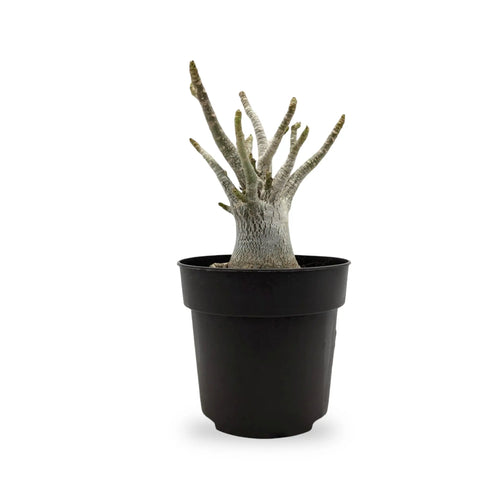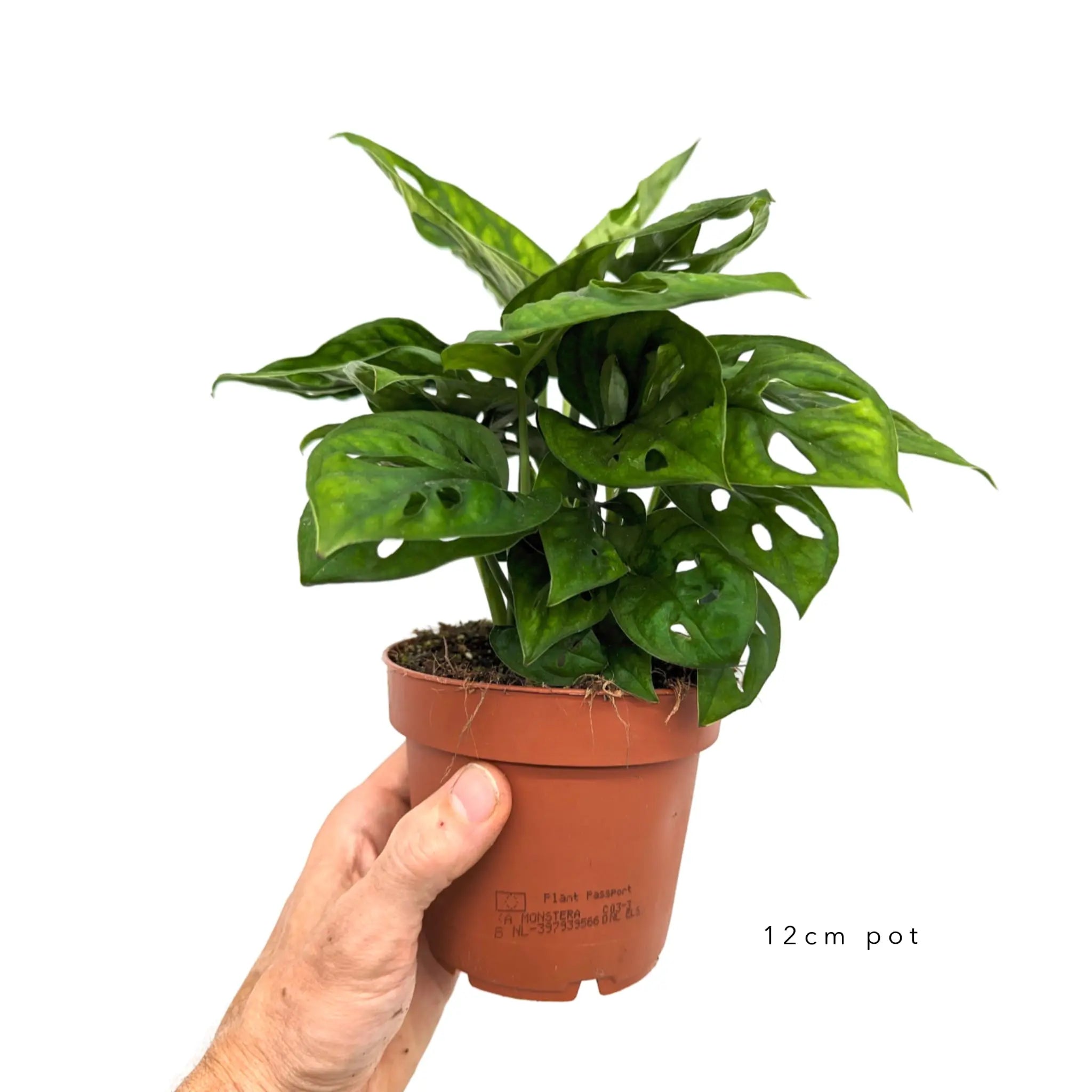Discover the captivating allure of the Monstera Adansonii, commonly known as the Monkey Mask plant. With its unique and intricate leaf patterns, this tropical beauty is sure to intrigue plant enthusiasts and collectors alike.
Bringing a touch of the wild into your home, this plant showcases a mesmerizing display of fenestrations, resulting in its distinct resemblance to a monkey's face. Native to the rainforests of Central and South America, the Monstera Adansonii thrives in warm and humid environments.
Not only is the Monstera Adansonii visually stunning, but it also offers a range of benefits. Its large leaves act as natural air purifiers, effectively removing toxins and improving indoor air quality. Additionally, caring for this plant is relatively easy, making it an excellent choice for both experienced and novice plant lovers.
Whether you're looking to create a lush jungle atmosphere in your living space or adding a touch of nature to your workplace, the Monstera Adansonii is the perfect green companion. Join us as we explore the fascinating world of this unique and beautiful plant.

The Monstera Adansonii, also known as the Monkey Mask plant, has a rich history dating back centuries. This tropical plant is native to the rainforests of Central and South America, where it can be found growing on trees, rocks, and other plants. Its scientific name, Monstera Adansonii, is derived from the Latin word "monstrum," meaning monster, in reference to its large and unique leaves.
The Monkey Mask plant has been cultivated and admired for its distinctive leaf patterns since the 18th century. It was first introduced to Europe by French botanist Michel Adanson, who discovered the plant on his travels to the Americas. Since then, it has gained popularity among plant enthusiasts and collectors worldwide.
The Monstera Adansonii is a vine-like plant that belongs to the Araceae family. It is characterised by its heart-shaped leaves that feature intricate patterns of holes and cuts, known as fenestrations. These fenestrations give the leaves their distinct resemblance to a monkey's face, hence the common name Monkey Mask plant.

The leaves of the Monstera Adansonii can grow up to 25cm long and 15cm wide, making them a striking focal point in any indoor or outdoor space. The plant also produces long, slender stems that allow it to climb and attach itself to surfaces using aerial roots. These roots not only provide support but also absorb moisture and nutrients from the air.
In addition to its unique leaf patterns, the Monkey Mask plant produces small, white flowers that develop into edible fruit. However, it is important to note that the fruit of the Monstera Adansonii is not commonly consumed and can be toxic if not properly prepared.
Cultivating and caring for the Monstera Adansonii is relatively easy, making it a popular choice for both experienced and novice plant lovers. This tropical plant thrives in warm and humid environments, similar to its natural habitat in the rainforests of Central and South America.
When it comes to lighting, the Monkey Mask plant prefers bright, indirect light. Placing it near a north or east-facing window is ideal, as direct sunlight can scorch its delicate leaves. However, it can tolerate lower light conditions, making it suitable for areas with less natural light.
As for watering, it is important to keep the soil consistently moist but not waterlogged. Overwatering can lead to root rot, while underwatering can cause the leaves to wilt and droop. To maintain the right moisture balance, water the Monstera Adansonii thoroughly when the top inch of soil feels dry to the touch.
Humidity is also crucial for the health and growth of the Monkey Mask plant. It thrives in environments with humidity levels between 60% and 80%. To increase humidity, you can mist the leaves regularly or place the plant on a tray filled with water and pebbles. Another option is to use a humidifier to create the ideal moisture level.
In terms of soil, the Monstera Adansonii prefers a well-draining potting mix that retains moisture without becoming waterlogged. A mixture of peat moss, perlite, and orchid bark is suitable for this plant. Repotting is typically done every one to two years, or when the roots outgrow the current pot.
Propagation of the Monstera Adansonii can be done through various methods, including stem cuttings and air layering. Stem cuttings are the most common and straightforward way to propagate this plant.
To propagate using stem cuttings, select a healthy stem with at least two leaves. Using a clean, sharp knife or shears, make a clean cut just below a node, which is a point on the stem where leaves or aerial roots emerge. Remove any leaves near the cut, leaving only one or two at the top.
Next, prepare a small pot with a well-draining potting mix and create a hole in the center. Insert the stem cutting into the hole, making sure the node is buried in the soil. Gently press the soil around the cutting to secure it.
Place the pot in a warm and humid location with bright, indirect light. Mist the cutting regularly to maintain moisture and cover it with a plastic bag or a clear plastic dome to create a mini greenhouse effect. After a few weeks, roots should start to develop, indicating successful propagation.
Like any other plant, the Monstera Adansonii is susceptible to certain pests and diseases. However, with proper care and maintenance, these issues can be minimized or prevented.
One common pest that affects the Monkey Mask plant is the spider mite. These tiny insects can cause damage by feeding on the plant's leaves, resulting in yellowing, stippling, and webbing. Regularly inspecting the plant for any signs of spider mites and promptly treating them with insecticidal soap or neem oil can help control the infestation.
Another pest to watch out for is the mealybug. These small, white insects can be found on the undersides of leaves or in the leaf axils. They feed by piercing the plant and sucking out its sap, leading to stunted growth and yellowing leaves. Manual removal of mealybugs using a cotton swab dipped in rubbing alcohol or insecticidal soap can help eliminate the infestation.
In terms of diseases, root rot is a common problem that can occur if the Monstera Adansonii is overwatered or planted in soil that retains too much moisture. To prevent root rot, it is important to ensure proper drainage and avoid overwatering. If root rot does occur, it may be necessary to repot the plant in fresh, well-draining soil and trim away any affected roots.

The Monstera Adansonii has several unique varieties and hybrids that offer different leaf shapes, sizes, and colors. These variations add even more intrigue and diversity to the fascinating world of this plant.
One popular variety is the Monstera Adansonii 'Swiss Cheese'. It features larger and more pronounced fenestrations, giving it a more dramatic appearance. The 'Swiss Cheese' variety is highly sought after by collectors and plant enthusiasts for its unique leaf patterns.
Another interesting variety is the Monstera Adansonii 'Variegata'. This variety has leaves with variegated patterns, featuring shades of white, cream, or yellow alongside the typical green color. The variegated leaves add a touch of elegance and uniqueness to the Monkey Mask plant, making it a prized and rare find.
In addition to these varieties, there are also hybrids of the Monstera Adansonii available in the market. These hybrids are created by crossbreeding the Monkey Mask plant with other Monstera species or related plants. The resulting hybrids can exhibit a combination of traits from both parent plants, offering a wide range of leaf shapes, sizes, and colors.
The Monstera Adansonii is a versatile plant that can be used to enhance the aesthetics of any space. Whether you're looking to create a lush jungle atmosphere or add a touch of nature to your existing decor, the Monkey Mask plant offers endless possibilities.
One popular way to incorporate the Monstera Adansonii into your home is by placing it in a decorative pot or planter. Choose a pot that complements your interior style and allows the plant to stand out. You can opt for a minimalist white pot for a modern look or a colorful ceramic pot for a bohemian vibe.
Another idea is to create a focal point by displaying the Monkey Mask plant in a hanging planter. This not only adds visual interest but also saves valuable floor space. Hang the planter near a window or in a corner to create a cascading effect, allowing the plant to showcase its beautiful leaves.
For those who prefer a more dramatic statement, consider training the Monstera Adansonii onto a trellis or moss pole. This allows the plant to climb and grow vertically, adding height and texture to your space. Place the trellis or moss pole against a wall or in an empty corner to create a stunning green backdrop.
To create a tropical oasis, pair the Monkey Mask plant with other lush and exotic plants. Combine it with plants like the Philodendron, Calathea, or Bird of Paradise for a vibrant and tropical display. This creates a harmonious and balanced look, bringing the beauty of the rainforest into your home.
The Monstera Adansonii, with its unique and intricate leaf patterns, is a fascinating plant that captivates plant enthusiasts and collectors worldwide. From its history and physical characteristics to its cultivation and care, this tropical beauty offers a range of benefits and possibilities.
With its ability to purify the air, create a calming atmosphere, and add visual interest to any space, the Monstera Adansonii is the perfect green companion. Whether you're a seasoned plant lover or just starting your plant journey, this unique and beautiful plant is sure to bring joy and beauty into your life.
So why not bring a touch of the wild into your home and explore the fascinating world of the Monkey Mask plant? Discover the allure of its fenestrated leaves, propagate your own plants, and experiment with different varieties and hybrids. With the Monstera Adansonii, the possibilities are endless, and the enjoyment is guaranteed.










